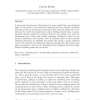Free Online Productivity Tools
i2Speak
i2Symbol
i2OCR
iTex2Img
iWeb2Print
iWeb2Shot
i2Type
iPdf2Split
iPdf2Merge
i2Bopomofo
i2Arabic
i2Style
i2Image
i2PDF
iLatex2Rtf
Sci2ools
IVC
2002
2002
A new approach to vanishing point detection in architectural environments
A man-made environment is characterized by many parallel lines and orthogonal edges. In this article, a new method for detecting the three mutually orthogonal directions of such an environment is presented. Since real-time performance is not necessary for architectural applications, such as building reconstruction, a computationally intensive approach was chosen. However, this enables us to avoid one fundamental error of most other existing techniques. Compared to theirs, our approach is furthermore more rigorous, since all conditions given by three mutually orthogonal directions are identified and utilized. We assume a partly calibrated camera with unknown focal length and unknown principal point. By examine these camera parameters, which can be determined from orthogonal directions, falsely detected vanishing points may be rejected. Key words: Vanishing points, vanishing lines, geometric constraints, architecture, camera calibration
| Added | 22 Dec 2010 |
| Updated | 22 Dec 2010 |
| Type | Journal |
| Year | 2002 |
| Where | IVC |
| Authors | Carsten Rother |
Comments (0)

